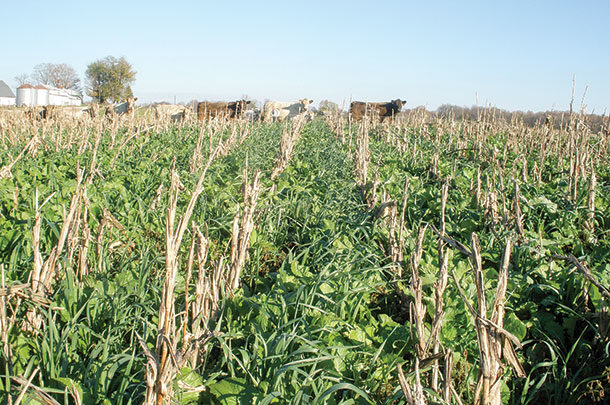As spring plantings begin in earnest, there are a number of important factors to consider if you plan on extending your grazing opportunities with cover crops. By following these five important steps, you should have a successful year grazing cover crops.
1. Plan your chemical program
Choose the chemical program for each of the fields you plan to plant cover crops in. I have seen too many producers who did not plan well in this area, and it virtually eliminated the opportunity to plant cover crops or to graze them.
A number of years ago, I was visiting a dairy near Bad Axe, Michigan. They were planting cover crops after wheat to be grazed by their cows and heifers. The previous year, the mixture of oats and a hybrid brassica was beautiful and very productive.
However, this particular year, the same cover crop mixture was pale green, and the hybrid brassica was short and discolored.
The producer was not pleased and wondered if the seed he used was not as good as the year prior. Knowing that wasn’t the case, I asked him what had changed in his system. Was there a seed change? No change. Fertility program change? No change. Chemical program change? Yes.
A new chemical was used and while it was effective to control weeds, it also created a sizeable loss in yield and quality of the cover crop.
The University of Wisconsin Extension along with Wisconsin Crop Weed Science has published an outstanding publication, “Herbicide Rotation Restrictions in Forage and Cover Cropping Systems” that helps producers select the right chemical program to allow for a healthy cover crop.
You will find that many commonly used herbicides have a long half-life and may not be able to be used if you want to plant cover crops. Even if you can successfully establish a cover crop after some of the chemicals, you may not be able to graze that cover crop. It is vital you know what chemicals cannot be used if you wish to graze cover crops. Always follow label directions.
2. Plan your fertility program
I know this might seem odd because nearly everyone fertilizes cash crops for top success, but I have met some resistance when recommending producers fertilize a cover crop. If you have manure to spread on your fields, it’s a very solid practice to put on 5,000 gallons of liquid manure or more. However, it is important to know how much nitrogen is in the manure.
I have worked with producers who put on 6,000 gallons of manure and had cover crops that were nitrogen starved. In a number of cases, we found that there was only around 5 pounds of nitrogen per 1,000 gallons, and 30 pounds of nitrogen is not enough to adequately feed a cover crop.
So how much nitrogen should be used? If there is not a legume present in the cover crop mixture, a good rule of thumb is to apply 50 pounds of nitrogen to grass cover crops. If you’re using sudangrass or sorghum-sudangrass, applying up to 75 pounds of nitrogen at planting time will likely prove beneficial.
If legumes are in the cover crop mixture, it is not normally necessary to add additional nitrogen. The key to this statement is that the legumes be inoculated with the proper inoculant so the legumes can fix nitrogen.
Crimson clover, cover crop peas or hairy vetch can produce over 100 pounds of nitrogen when planted after wheat or other cereal grains. When planted late summer into standing corn, you will likely find 30 to 50 percent of that amount, depending on how tall the legume gets in the fall.
3. Plan your seeding program
No-tilling seed into wheat stubble works well, especially if the straw is removed. Seeding depth is important to monitor as peas and oats can be planted as deep as 2 inches (even with radishes), whereas crimson clover and annual ryegrass need to be planted no deeper than 0.5 inch.
When establishing a cover crop into standing corn, it is important to apply at the right time. I have found the most consistent stands occur when the cover crops are applied when the corn hits black layer or when approximately 50 percent of the sunlight reaches the ground in the field.
In many areas, aerial application works exceptionally well for applying cover crops into standing cash crops. There are many aerial applicators across the country that do an excellent job of applying cover crops. High-clearance ground applicators work well also.
4. Plan what cover crop species you will use
Depending on when the cover crops are applied, and how long of a growing season is left after the cover crops establish, will determine the best options for you. After a cereal grain crop is harvested, the “toolbox” is wide open to choose species from. While it is not necessary, many producers like a multispecies mixture after the cereal grain harvest. I have seen producers use three to four species and others with 16-way mixes – both excited about the benefit and the animal production from grazing both types of mixes.
If you’re applying aerially into standing corn, the species that seem to be consistent in establishing, and are excellent for grazing, include grasses like annual ryegrass, winter cereal rye, oats and spring barley. Legumes that consistently do well are crimson clover and hairy vetch.
Radishes, turnips, hybrid brassicas and forage rapeseed all establish well aerially applied and are also highly productive.
Mixing a grass, plus legume, plus brassica (or radish) together (any number of species of each group) can make for excellent fall, winter and spring grazing. My personal favorite is mixing winter cereal rye with oats and grazing turnips.
The oats and grazing turnips grow very quickly in the fall and provide an excellent opportunity for high grazing yields. Over the winter and into the spring, the rye can be grazed before the next cash crop is established.
5. Plan your grazing program
Grazing cover crops, along with corn stalks, can provide most of the winter feed for cattle in much of the country. Grazing cover crops, after harvesting a cereal grain crop, can provide excellent feed during the time cool-season pastures are in their summer slump.
To best utilize the value of the forage, it is best to either strip graze, rotationally graze or possibly mob graze the cover crops. All of these practices are far more efficient than letting the animals loose to run the whole field.
Whatever practice is chosen, it is important animals have access to clean water at all times. It is also advisable to provide free-choice minerals. If there are no corn stalks to graze, it is important to have dry grass hay (or good straw) available at all times.
Animals will balance their ration well and eat the corn stalks or grass hay when they’ve had too much rich forage.
With these five steps, you should be well on your way to a successful and profitable practice, while both building soil and producing a significant amount of quality feed. ![]()
PHOTO: You’ve heard it time and again; grazing cover crops is an excellent way to improve soil health and add some extra pounds to your livestock. But what is it that makes some producers more successful than others? Photo provided by Dave Robison.
For more information on grazing cover crops, visit Dave’s blog at Plant Cover Crops.
Dave Robison is the forage and cover crop manager for Legacy Seeds Inc. Email Dave Robinson.











